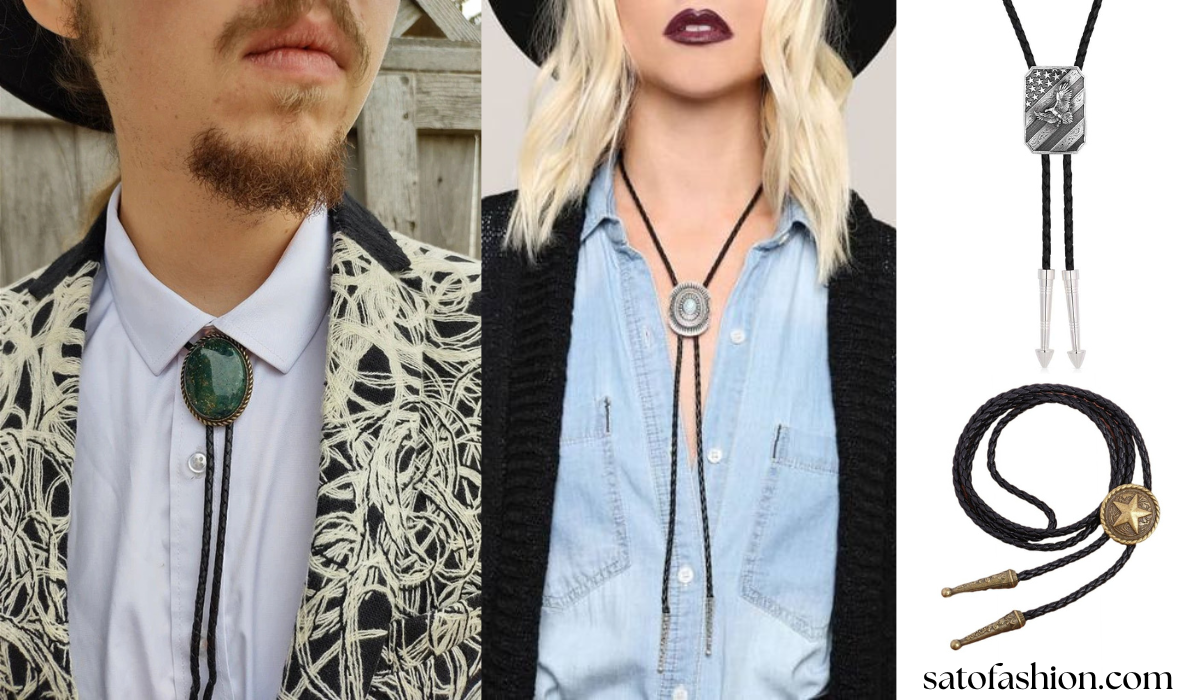The bolo tie, an iconic symbol of American Western heritage, has long transcended its roots to become a global accessory for those seeking a blend of individuality and elegance. From the sun-scorched deserts of Arizona to the humid streets of Savannah, and even onto the runways of high fashion, the bolo tie’s distinctive slide-and-cord design offers a unique alternative to the traditional necktie or necklace. However, for those who lead active lives or reside in warmer climates, a significant challenge arises: the damaging effects of perspiration on this cherished accessory. This is where the concept of the sweat-resistant bolo tie becomes not just a feature, but an essential consideration for longevity and wearability.
This article explores the world of sweat-resistant bolo ties, demystifying what makes them durable, the materials involved, and how to choose and care for one. It’s an informational journey into the practical side of preserving a piece of wearable art.
Understanding the Adversary: Why Sweat is Damaging
To appreciate sweat resistance, one must first understand why sweat is so detrimental to jewelry and accessories. Perspiration is not just salt water; it’s a complex mixture of water, sodium chloride, lipids, and acids. When this mixture comes into constant contact with metals, leather, and stones, it initiates a series of corrosive processes.
- Metal Tarnishing and Corrosion: Metals like sterling silver, brass, and copper are particularly vulnerable. The salts and chlorides in sweat accelerate tarnishing, leading to a dull, blackened appearance. For plated metals, persistent sweat can wear through the thin layer of gold, silver, or rhodium, exposing the less valuable base metal underneath. This can cause unsightly spotting and greenish stains on the skin.
- Leather Degradation: The leather cords, which are a hallmark of bolo ties, are organic materials. Sweat dries out the natural oils in leather, making it brittle, stiff, and prone to cracking. The moisture can also cause the leather to stretch and lose its shape over time.
- Stone and Adhesive Damage: For bolo ties with inlaid stones like turquoise, coral, or mother-of-pearl, sweat can seep into the porous stones, potentially altering their color or clarity. Furthermore, the adhesives used to secure stones or backing can break down when exposed to moisture, leading to loose or lost components.
A sweat-resistant bolo tie is specifically designed or treated to mitigate these effects, ensuring the accessory remains beautiful and intact for years, even with regular wear.
The Anatomy of a Sweat Resistant Bolo Tie
Sweat resistance is not achieved through a single magical component but through a combination of material choices, construction techniques, and protective finishes.
1. The Slide: Choosing the Right Metal
The slide is the centerpiece of the bolo tie, and its metal composition is the first line of defense.
- Stainless Steel: A top choice for sweat resistance, stainless steel contains chromium, which forms an invisible passive layer of chromium oxide that protects against rust and corrosion. It is exceptionally durable and hypoallergenic.
- Titanium: Even more resilient than stainless steel, titanium is incredibly strong, lightweight, and completely impervious to corrosion from body sweat. It is also hypoallergenic, making it ideal for those with sensitive skin.
- Tungsten Carbide: Known for its extreme hardness and scratch resistance, tungsten carbide is another excellent option that holds a high polish and is largely unaffected by sweat.
- High-Quality Plating: For those who prefer the look of gold or silver, a high-quality plating over a sweat-resistant base metal like brass or stainless steel can be effective. The key is the thickness of the plating (often measured in microns) and the quality of the underlying seal. Look for terms like “heavy gold electroplate” or “PVD coating,” which are more durable than standard plating.
- Sterling Silver with a Protective Finish: While sterling silver (925) is prone to tarnish, many manufacturers now apply clear, anti-tarnish coatings (e.g., lacquer or rhodium plating) that create a barrier between the metal and sweat. This coating will eventually wear off with intense friction but significantly prolongs the time between polishings.
2. The Cord: Beyond Traditional Leather
The cord must be both stylish and resilient.
- Synthetic Leather (PU or Vegan Leather): High-quality polyurethane (PU) cords are an excellent sweat-resistant alternative to genuine leather. They are non-porous, easy to clean with a damp cloth, and will not dry out or crack.
- Waxed Cotton or Synthetic Fibers: Braided waxed cotton cords or cords made from materials like nylon offer durability and moisture resistance. They are less formal than leather but are practical for casual, everyday wear.
- Treating Leather Cords: If you prefer genuine leather, look for cords that have been treated with a protective conditioner or sealant. Applying a leather protector spray yourself can add a layer of defense against moisture.
3. The Tips and Ends
The metal tips (aglets) that finish the ends of the cord should be made from the same corrosion-resistant metals as the slide to prevent a weak link in the chain of durability.
Care and Maintenance: Maximizing Longevity
Even the most sweat-resistant bolo tie requires proper care.
- Wipe Down After Wear: The single most effective habit is to gently wipe the entire bolo tie—slide, cord, and tips—with a soft, lint-free cloth after each wear. This removes sweat, oils, and dirt before they have a chance to cause damage.
- Store Properly: Keep your bolo tie in a cool, dry place, ideally in a soft pouch or a box lined with anti-tarnish cloth. Avoid hanging it in a humid bathroom.
- Avoid Harsh Chemicals: Remove your bolo tie before applying perfumes, colognes, hairsprays, or sunscreen, as these chemicals can break down protective finishes.
- Periodic Deep Cleaning: For metal slides, use a polishing cloth designed for that specific metal. For synthetic cords, a slightly damp cloth is sufficient. For genuine leather cords, use a leather cleaner and conditioner sparingly to maintain flexibility.
Informational FAQs
Q1: Are sweat-resistant bolo ties completely waterproof?
A: Not necessarily. “Sweat-resistant” means they are designed to withstand the occasional exposure to perspiration and can be easily wiped clean. They are not typically designed for submersion in water, such as swimming or showering. Always check the manufacturer’s care instructions.
Q2: Can I make my existing non-resistant bolo tie more sweat-resistant?
A: To some extent, yes. You can apply a jeweler’s lacquer to metal components (though this may alter the finish) and use a leather protector spray on leather cords. However, the most effective solution is to purchase a bolo tie designed with sweat-resistant materials from the outset.
Q3: Are these bolo ties suitable for people with metal allergies?
A: Yes, many are. Sweat-resistant metals like stainless steel and titanium are generally hypoallergenic and are excellent choices for individuals with nickel or other metal sensitivities.
Q4: Where can I find sweat-resistant bolo ties?
A: Look for artisans and retailers who specify the materials used. Descriptions that highlight “stainless steel,” “titanium,” “tungsten,” “PVD coating,” or “synthetic cord” are good indicators. Many custom bolo tie makers can also create pieces using these durable materials upon request.
Q5: Does a sweat-resistant bolo tie look different from a traditional one?
A: Not at all. Advances in metallurgy and material science mean that a sweat-resistant bolo tie can have the same aesthetic appeal, from a rustic Southwestern look with a turquoise-like acrylic stone to a sleek, modern minimalist design. The durability is built into the material properties, not the appearance.
Conclusion
A sweat-resistant bolo tie is a smart investment for anyone who appreciates the unique style of this accessory but doesn’t want to relegate it to occasional, fair-weather wear. By understanding the materials and construction that contribute to its durability, and by adopting simple maintenance habits, you can ensure your bolo tie remains a vibrant and personal statement piece for a lifetime. It’s the perfect marriage of timeless Western style and modern, practical innovation.

